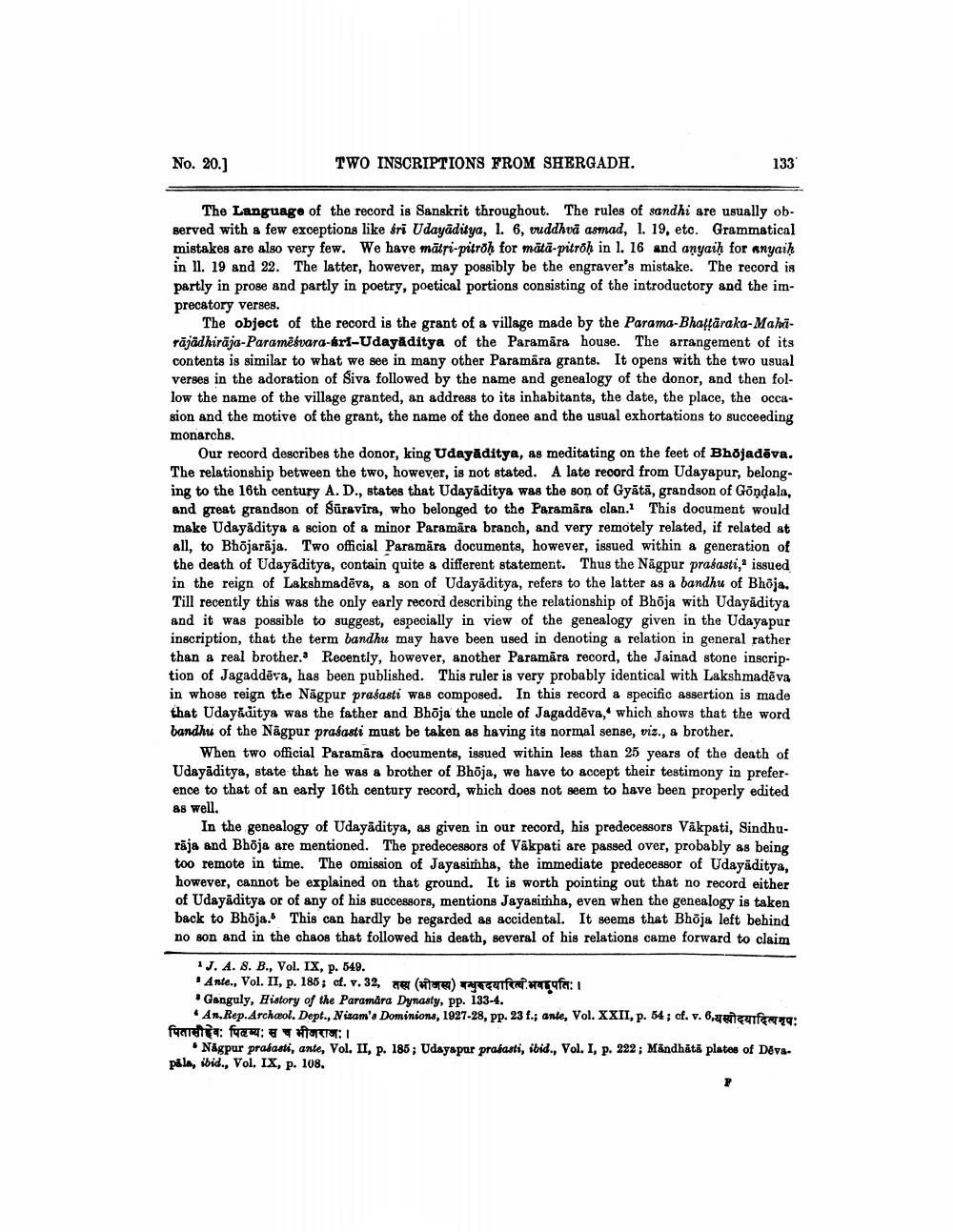________________
No. 20.]
TWO INSCRIPTIONS FROM SHERGADH.
133
The Language of the record is Sanskrit throughout. The rules of sandhi are usually observed with a few exceptions like fri Udayāditya, 1. 6, vuddhva asmad, 1. 19. etc. Grammatical mistakes are also very few. We have mātri-pitroh for mātā-pitro” in l. 16 and anyaiḥ for anyaih in 11. 19 and 22. The latter, however, may possibly be the engraver's mistake. The record is partly in prose and partly in poetry, poetical portions consisting of the introductory and the imprecatory verses.
The object of the record is the grant of a village made by the Parama-Bhaltāraka-Malirājadhiraja-Paramesvara-bri-Udayaditya of the Paramāra house. The arrangement of its contents is similar to what we see in many other Paramāra grants. It opens with the two usual verses in the adoration of Siva followed by the name and genealogy of the donor, and then follow the name of the village granted, an address to its inhabitants, the date, the place, the occasion and the motive of the grant, the name of the donee and the usual exhortations to succeeding monarchs.
Our record describes the donor, king Udayāditya, as meditating on the feet of Bhöjadēva. The relationship between the two, however, is not stated. A late record from Udayapur, belonging to the 16th century A.D., states that Udayaditya was the son of Gyātā, grandson of Göndala, and great grandson of Sūravira, who belonged to the Paramāra clan. This document would make Udayāditya a scion of a minor Paramāra branch, and very remotely related, if related at all, to Bhöjarāja. Two official Paramāra documents, however, issued within a generation of the death of Udayāditya, contain quite & different statement. Thus the Nāgpur prasasti, issued in the reign of Lakshmadēva, & son of Udayāditya, refers to the latter as a bandhu of Bhoja. Till recently this was the only early record describing the relationship of Bhoja with Udayāditya and it was possible to suggest, especially in view of the genealogy given in the Udayapur inscription, that the term bandhu may have been used in denoting a relation in general rather than a real brother. Recently, however, another Paramāra record, the Jainad stone inscription of Jagaddēva, has been published. This ruler is very probably identical with Lakshmadēva in whose reign the Nāgpur prasasti was composed. In this record a specific assertion is made that Udayaditya was the father and Bhõja the uncle of Jagaddēva, which shows that the word bandhu of the Nāgpur prasasti must be taken as having its normal sense, viz., a brother.
When two official Paramāra documents, issued within less than 25 years of the death of Udayāditya, state that he was a brother of Bhoja, we have to accept their testimony in preference to that of an early 16th century record, which does not seem to have been properly edited as well.
In the genealogy of Udayāditya, as given in our record, his predecessors Vākpati, Sindhurāja and Bhöja are mentioned. The predecessors of Vākpati are passed over, probably as being too remote in time. The omission of Jayasimha, the immediate predecessor of Udayaditya. however, cannot be explained on that ground. It is worth pointing out that no record either of Udayāditya or of any of his successors, mentions Jayasimha, even when the genealogy is taken back to Bhoja. This can hardly be regarded as accidental. It seems that Bhoja left behind no son and in the chaos that followed his death, several of his relations came forward to claim
1J.A. 8. B., Vol. IX, p. 549. * Ante., Vol. II, p. 185; cf. v. 32, net ( r) rayauf u fa: . Ganguly, History of the Paramära Dynasty, pp. 133-4.
• An. Rep. Archæol. Dept., Nisam'a Dominions, 1927-28, pp. 23 f.; ante, Vol. XXII, p. 64; cf. v. 6. cafeaua: पितासीहवः पिवण्यः स च भीजराजः।
Någpur prasasti, ante, Vol. II, p. 185; Udayapur prasasti, ibid., Vol. I, p. 222; Mändhätă plates of Dévapåla, ibid., Vol. IX, p. 108.




